![]()
![]()
![]()
Use LEFT and RIGHT arrow keys to navigate between flashcards;
Use UP and DOWN arrow keys to flip the card;
H to show hint;
A reads text to speech;
63 Cards in this Set
- Front
- Back
|
What are archaea known as, and what are their 3 types? |
Extremophiles: - Thermophile (heat) - Halophile (salt) - Methanogens (methane) |
|
|
Where do protists live? |
Moist/aquatic habitats. |
|
|
What are the photosynthesizing protists called? What are the animal like protists called? |
Algae Protozoa (ex. amoeba) |
|
|
What are the layers of the bacteria? |
Slime layer → Cell wall → Membrane |
|
|
What is the difference between prokaryotic and eukaryotic flagella? |
Eukaryotic: Made of microtubules Prokaryotic: Made of flagellin |
|
|
What is chemitaxis? |
The sensing of chemicals and subsequent moving away/towards it, executed by prokaryotes. |
|
|
Cilia in bacteria are called ____________. |
Pili/fimbriae (made of pilin). |
|
|
What is the genetic material found in bacteria? |
Circular dsDNA in nucleoid area + Plasmid(s) |
|
|
What are the storage "organelles" for bacteria? |
Inclusion bodies. |
|
|
What are the 3 main shapes of the bacterium? |
Coccus (sphere) Bacillus (rod) Spirochete (spiral) |
|
|
Gram + stains __________. |
Purple |
|
|
Gram - stains __________. |
Pink |
|
|
What is the cell wall like in Gram POS bacteria? |

Membrane : Thick peptidoglycan : Slime |
|
|
What is the cell wall like in Gram NEG bacteria? |
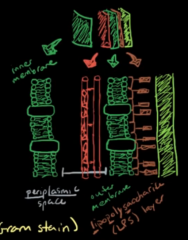
Membrane : Thin peptidoglycan : Outer Membrane : Lipopolysaccharide (LPS) : Capsule |
|
|
What is peptidoglycan made of? |
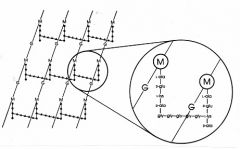
MurNAc (NAM) + GlcNAc (NAG) sugars AAs off of NAM bound to eachother. |
|
|
What are the connections between NAG and NAM in peptidoglycan? |
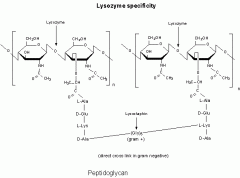
B(1-4). Lysozyme can cleave it. |
|
|
What are the steps of gram staining? |
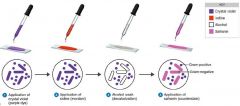
1. Crystal violet 2. Iodine 3. Wash 4. Alcohol (to decolour) 5. Safarin |
|
|
What is binary fission? |
Bacterial binary fission is the asexual reproductive process that bacteria use to carry out cell division. Binary fission is similar in concept to the mitosis that happens in eukaryotic organisms (such as plants and animals), but its purpose is different. |
|
|
Where does DNA replication happen? Are there more than one areas for this? |
Only one: origin of replication. High AT content. |
|
|
Where is the periplasmic space in Gram NEG bacteria? |
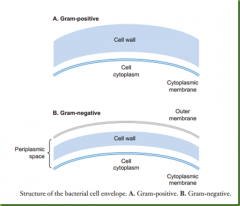
Between membranes. |
|
|
What is the border that forms between the two new cells called? |
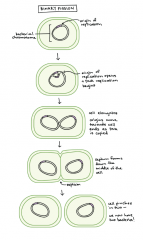
Septum. |
|
|
Is there the formation of a mitotic spindle in binary fission? |
No! |
|
|
Does DNA replication happen before separation during binary fission (as it does in mitosis)? |
No! At the same time. |
|
|
What are the 3 AAs found in Peptidoglycan (off NAM) that are not found in humans? |
L-Ala D-Glu mDap D-Ala D-Ala |
|
|
What are the three alternative forms of genetic recombination in bacteria? |
Conjugation Transformation Transduction |
|
|
What is conjugation? |
Transfer of a plasmid (small circle of extragenomic DNA) via a pilus. |
|
|
Plasmids that are able to integrate into the chromosome are called _____________. |
episomes. |
|
|
How does conjugation happen? |
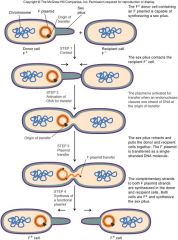
- F+ grows sex pilus - Endonuclease cleaves one strand of F-plasmid - Pilus brings cells together - F+ transfers this strand to F- |
|
|
What is a conjugative plasmid and what are its types? |
Plasmid that possesses the genes for the sex pilus. F-plasmid: Fertility factor. ("F+" if bacterium has) R-plasmid: Conjugative, but also donates resistance |
|
|
What is transformation? |
Incorporation of environmental DNA into the bacteria's genome. Bacteria can release their DNA via electroporation or heat shock. |
|
|
What is transduction? |
The transfer of DNA between bacteria by a viral vector. Virus can mistakenly encapsulate host DNA in its capsule, and transfer this harmless genetic material. |
|
|
Methicillin-resistant Staphylococcus aureus (MRSA) is an antibiotic-resistant “superbug” that can cause deadly infections in humans. What would these Gram-positive bacteria look like under a microscope? |
Purple Spheres |
|
|
ProblemMethanopyrus kandleri is an organism which lives in a hydrogen-carbon dioxide environment, and was first discovered in a hydrothermal vent where temperatures reached 230°F. What sort of organism is this? |
Archaea. |
|
|
Which of the following is NOT found in both prokaryotes and eukaryotes? Ribosomes Cytoskeleton dsDNA Nucleolus |
Nucleolus. |
|
|
Are gram NEG or gram POS more likely to cause systemic effects, and why? |
Gram-negative bacteria are more likely to cause systemic effects because their outer membrane protects them from several antibiotics, making treatment more difficult |
|
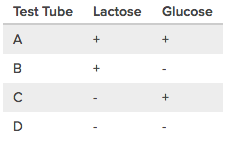
Scientists have developed a dye for galactose, which turns darker shades of blue as the concentration of this monosaccharide increases (dose dependent). In an experiment using bacteria that can metabolize both lactose and glucose, researchers set up test tubes as shown in Table 1. A plus sign indicates a sugar was added to the test tube, and a minus sign indicates the sugar is absent. Assuming bacterial concentrations stay constant, which test tube will show the strongest blue color? |
- The lac operon that controls lactose digestion in prokaryotes normally operates at a very low basal level, and is upregulated by the presence of its substrate. - Lactose is a dimer of galactose and glucose. - The absence of glucose leads to an increase in cAMP, because now the cell must rely much more heavily on the lac operon for energy. This sets off a cascade of events that upregulate the enzymes that cleaves lactose. - The presence of lactose and absence of glucose will lead to the most galactose and thus will dye the most strongly blue (Answer B). |
|
|
What type(s) of cells do you obtain after a F+ bacterium conjugates with a F- bacterium? |
Two F+ bacteria w/ identical plasmids, but perhaps different chromosomes. |
|
|
Where does energy production take place in bacteria that can perform aerobic metabolism? |
Plasma Membrane - Bacteria, like eukaryotes, rely on a concentration gradient to drive an ATP synthase molecule. - Bacteria are prokaryotes, and do not have membrane-bound organelles. - Energy production in bacteria takes place across the plasma membrane, with the gradient between the extra- and intracellular environment providing the appropriate concentration gradient |
|
|
Porphyromonas gingivalis is a Gram-negative bacterium, found in the oral cavity, is negatively affected by the presence of oxygen. What term best describes this bacteria? |
Obligate anaerobe. - Aerobes require oxygen in their environment. - Aerotolerant anaerobes cannot use oxygen, but can tolerate it in their environment. - Since Porphyromonas gingivalis is harmed by the presence of oxygen, it is an obligate anaerobe. |
|
|
What is most responsible for bacterial cell motility? |
Flagella |
|
|
What are the 7 criteria for life? Which do viruses pass? |
1. Living things must maintain homeostasis (Fail) 2. Living things have different levels of organization (Pass) 3. Living things reproduce (Maybe) 4. Living things grow (Fail) 5. Living things use energy (Maybe) 6. Living things respond to stimuli (Unknown) 7. Living things adapt to their environment (Pass) |
|
|
What is the protein coat in viruses called? |
Capsid. All viruses have it. Made of capsomers in icosahedral, helical or spherical shape. |
|
|
Do all viruses have an envelope? |
No, but most animal viruses do. It is a lipid bilayer taken from the host. |
|
|
Can viruses have DNA or RNA? Both? |
Either, but not both. ssDNA ssRNA dsDNA dsRNA |
|
|
The capsid + nucleic acid = ________. |
Nucleocapsid. |
|
|
What are viruses? (OIP) |
Obligate intracellular parasite. |
|
|
What is specific about a bacteriophage? |
It infects bacteria, and injects its nucleic material in by its tail integument - once viral enzymes have digested a hole in the cell wall. It must recognize receptors on the host cell that are recognized by tail fibres. |
|
|
What are 3 ways for a virus to get inside a cell? |
1. Phage inserts genome 2. Non-enveloped virus use receptor-mediated endocytosis 3. Enveloped virus fuses w/ membrane |
|
|
What are the two possibilities of viral replication? |
Lytic!!!!! Lysogenic..... |
|
|
T/F: A lytic infection involves the translation of the viral RNA from its own ribosomes. |
False: uses the ribosomes of the host. |
|
|
T/F: Lysogenic infections involve the incorporation of viral genomic matter into the host genome. |
True. |
|
|
What is the viral genome called when it is incorporated into the host genome? |
Provirus/Prophage |
|
|
What are retroviruses? |
Enveloped ssRNA virus. Uses its own reverse transcriptase to make its RNA → cDNA (complementary) Integrase clips each of the 3' ends, making them sticky, and able to integrate into the genome! Viral mRNA is the transcribed, exists the HUMAN nucleus, and creates the proteins required to re-assemble into the retrovirus. They have an envelope. |
|
|
T/F: all RNA viruses have RNA-dependent RNA polymerase (RdRP)? |
True, and this is coded in their own genome, but uses the ribosomes of the host to produce the product. Once formed, this RdRP then replicates the RNA into -RNA and again into +RNA which codes for proteins. |
|
|
How do ssDNA viruses replicate? |
ssDNA enters the nucleus of host eukaryotic cell, and DNAp makes it into a dsDNA molecule, for integration into the genome. |
|
|
What are sub-viral particles? |
Infectious agents related to viruses. |
|
|
What are viroids? |
single strand of circular RNA, which only infect plants. |
|
|
Is hepatitis D a viroids or a prion? |
Viroid. |
|
|
What are prions? |
Protein, in B-sheet conformation that are able to infect animals. Also, they are able to replicate w/o DNA or RNA! |
|
|
A scientist is investigating a specimen in a laboratory. She is attempting to determine whether it is a virus or not. Which of the following would allow her to conclude that it is not a virus? Small Has protein coat Has DNA and RNA No organelles |
Has DNA and RNA. |
|
|
Which factor may help determine the antigenicity of a virus? |
Capsomers, as these are recognized by white blood cells. |
|
|
An antiviral drug specifically modifies viral receptors on a eukaryotic host cell. How might this affect the viral reproductive cycle? |
Prevent virus form attaching to host cell. |
|
|
Oncoviruses are a type of animal virus that can cause a neoplasm - an abnormal, often excessive, growth of tissue. Which type of virus is likely to be an oncovirus? |
Lysogenic |

